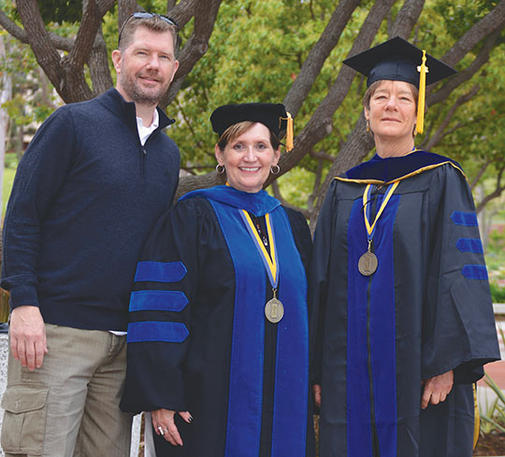Recent research has shown that the nonprofit sector, also known as the “third sector,” is in hiring mode. The 2016 Nonprofit Employment Practices Survey revealed that 57 percent of nonprofits expect to create new positions this year, an increase of 7 percent from 2015.
The report by Nonprofit HR – a human resources firm working with nonprofits in talent acquisition and training, as well as research – in partnership with GuideStar and The Improve Group took into account responses from 443 U.S. nonprofits.
However, the report indicated that for the past two years, one of the biggest challenges for nonprofits has been finding qualified staff as the sector has experienced a shift from an employers’ market to a jobseekers’ market.

James Schrage, MSW (left) is the executive director of the local nonprofit Families Uniting Families, which partners with California State University, Long Beach to hire interns and identify prospective employees. Schrage is pictured prior to the school’s graduation ceremony with Dr. Nancy-Meyers Adams, MSW, director of the school of social work (center), and Becki Sander, director of field education for the school. (Photograph by the Business Journal’s Larry Duncan)
The survey also found that 60 percent of nonprofits don’t have a formal recruitment strategy, and 77 percent do not have a formal recruitment budget. “Small organizations – those with an annual operating budget under $5 million – are especially lacking in this area: as many as 73 percent of small organizations do not have a formal recruitment strategy and 91 percent do not have a formal recruitment budget,” the report stated.
Anecdotally, Becki Sander, director of field education for the California State University, Long Beach School of Social Work, has observed that graduates of the program appear to be finding nonprofit work steadily. “The good news, from my perspective or the students’, is we don’t have students coming back to us and saying they can’t find employment,” she told the Business Journal. Due to the nature of social work, graduates of the program often work in the nonprofit field, or in the public sector for governmental agencies or schools, she noted.
Although competition in the field of social work is increasing – Sander pointed out that CSULB’s program is one of 10 in the region – she has observed a recent shift in which it seems students may have more employment options than in recent years.
“All the schools of social work come together to have a job fair every April for the graduates of both the undergraduate and graduate programs,” she said. “This year, the thing that jumped off the page is over 70 agencies [participated] – they have to pay to participate.” She added that last year slightly more than 50 agencies participated.
“The big news was two fold,” she continued. “One that was surprising, people anecdotally said they hadn’t seen that many agencies involved in awhile.” Good news. The other news, as reported to her by staff that attended the event, was that there appeared to be fewer graduates in attendance. “Some of the thoughts were – and again, we don’t know – but some of the thoughts were [students] had already reached out and had plans and leads,” she said.
Sander has also noticed that her department is increasingly receiving notices that field instructors, former students she works with at local nonprofits, have moved on to other positions, “meaning the job market has now picked up with services and so some of the people now have job mobility,” she explained.
Direct services positions, jobs that perform the functions of a nonprofit, are the hardest to fill, following by fundraising and development, according to the Nonprofit Employment Practices Survey.
“It’s not difficult to find a career in the not-for-profit sector. What is difficult is retaining people to want to stay in the nonprofit sector,” Jeffrey Wilcox, president and CEO of the Third Sector Company, said in an interview at the Business Journal’s offices. Wilcox’s company specializes in finding interim executives for the nonprofit sector.
Wilcox, who for years has been writing the Third Sector Report column for the Business Journal, noted that the difficulty nonprofits face in retaining employees is partially due to the increasing number of B Corporations (B Corps), which are essentially for-profit businesses operating for a cause.
The 2016 survey by Nonprofit HR made the same observation.
“With the emergence of social enterprises and growth of B Corps, an increasing number of revenue-generating entities are blending purpose and profit, which translates into jobseekers having even more opportunities to engage in mission-driven work than ever before,” the report stated. “Four years ago, there were only 100 certified B Corps. Today, that number has grown to more than 1,600 B Corps worldwide, covering 42 countries and 120 industries.”

California State University, Long Beach graduates from the school of social work, Gladys Cervantes (left) and Courtani Asher, visit with James Schrage, MSW, executive director of the local nonprofit Families Uniting Families. Schrage, who works with the school to find qualified social workers to assist his organization, attended the school’s pre-graduation reception last week. (Photograph by the Business Journal’s Larry Duncan)
Staying competitive with the private sector is another hurdle nonprofits are facing, according to the Nonprofit HR survey. “Maintaining salary budgets against market pressures” was identified as the No. 3 concern by nonprofit agencies surveyed.
“There will always be the hesitation about the income potential the sector has to offer career people,” Wilcox said, referring to the ability of nonprofits to attract executives. “There is a perception that professionals are undercompensated and it is not creating a full pipeline of candidates for career positions. And we’ve got to change that,” he said. “If we want to raise the level for arts and the environment and community, it takes paid professionals in order to do that. So we’re kind of at a crossroads.”
Jay Berger, partner with Morris & Berger, an L.A.-based executive search firm for the nonprofit sector, noted that it’s not uncommon that smaller nonprofits are unable to pay the salaries that executive applicants are requesting based on current or past pay. “Some times, it’s a smaller nonprofit and they can’t pay as much as someone’s already making, and the candidate’s not willing to take a salary cut, and it may not work,” he said.
But due to the cause-driven nature of the nonprofit sector, there are some who are willing to make sacrifices in salary, Berger pointed out. “In other cases, they are willing to take a salary cut. We just placed somebody in a position like that and she ended up taking about a $27,000 a year salary cut because she was really excited about this opportunity,” he recalled.
Wilcox said nonprofits need to reexamine how they define compensation, particularly when salary funding is an issue.
“Nonprofits today are having to be more creative in how they define compensation. In the old days, we only defined it as money,” he said. “I think you’re seeing a lot of not-for-profits that are saying, ‘Can we offer you a four-day work week instead of five? Can we offer you a virtual opportunity as opposed to always being in the office?’” In other words, nonprofits might be able to appeal to prospective executives and employees through what they can offer in the way of a work-life balance, he explained.
Another challenge to recruitment and retention is a degree of skepticism about the nonprofit sector’s ability to deliver on its promises. “We do have a generation of people who don’t feel that the nonprofit sector has delivered on some social promises – on such things as poverty and hunger and issues that are important to those of us who have chosen this as our career,” Wilcox said.
The position of development director, responsible for fundraising, is the most difficult to fill, Wilcox and Berger agreed. “We have a lot of burned out fundraisers who are facing the burden of raising charitable dollars all on their own while the rest of the organization stands back and tells them how they’re doing, or gives them suggestions on how they could do it better,” Wilcox said. It’s the position with all the pressure, he pointed out. “The difficulty with that one is I think we have turned fundraising into a sales transaction, when all along, fundraising was [meant to be] a community building and advocacy process. It never was a sales transaction.”
Berger pointed out that development directors are increasingly moving between jobs every couple of years, either because they didn’t meet fundraising expectations and were fired or because they’re unhappy.
Turnover at a nonprofit makes it more difficult to attract staff, Berger said. “If they’ve had a lot of turnover in that role, everybody’s going to question what’s the problem, why does this turnover exist?” he explained.
“The amount of time right now that not-for-profits are having to spend to find a good person is sending some organizations into tail spins because they’re just so vital for the organization to fulfill its mission,” Wilcox reflected.
But a difficulty with employee retention isn’t an issue exclusive to the nonprofit sector. “I think there is a societal tide going on about people not staying in jobs as long as they used to. So I don’t believe that’s just endemic to the nonprofit sector,” Wilcox said.
Wilcox said that most people in the nonprofit sector are not committed to the sector itself, but rather to the organization’s cause. “It is a commitment to a particular desire to change the world,” Wilcox said. “Where I think the nonprofit sector has a difficult time is people want careers that are based on a cause. They don’t want a career based on an organization.”
In addition to reexamining what compensation means and perhaps pursuing interim management to ease the transition period when there is an executive vacancy, appealing to the younger generations’ desire to enact societal change is something nonprofits should strive for, according to Wilcox.
“If you work for a nonprofit where the human resource equation is a balance between paid and unpaid people working together to do something fantastic, you’re probably going to see a much more energetic employee pool, because they’re working with people in the community to do something for the community,” Wilcox said. “That whole human resource equation is a big deal, because the not-for-profit sector is the only sector that can leverage that.”
